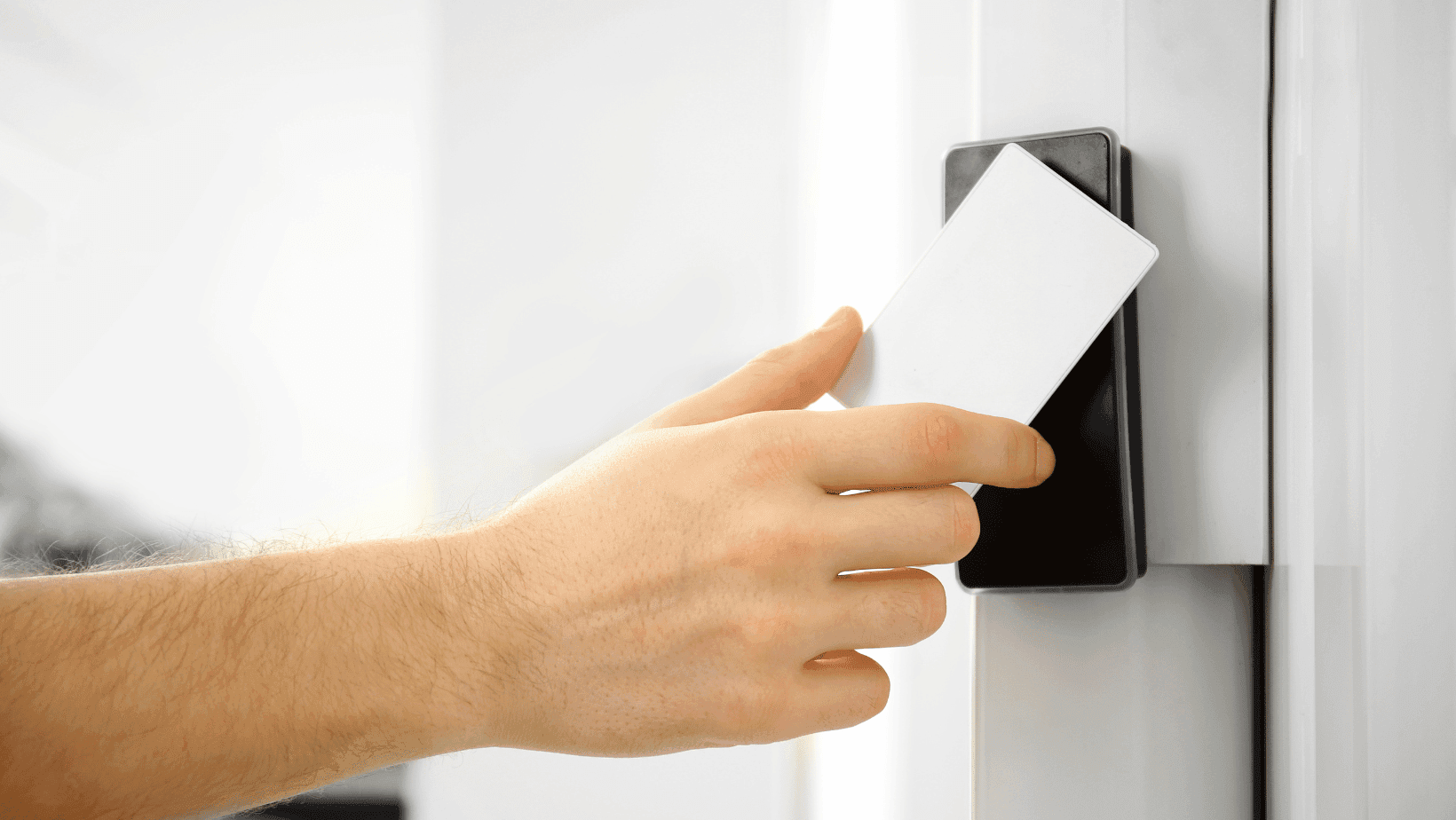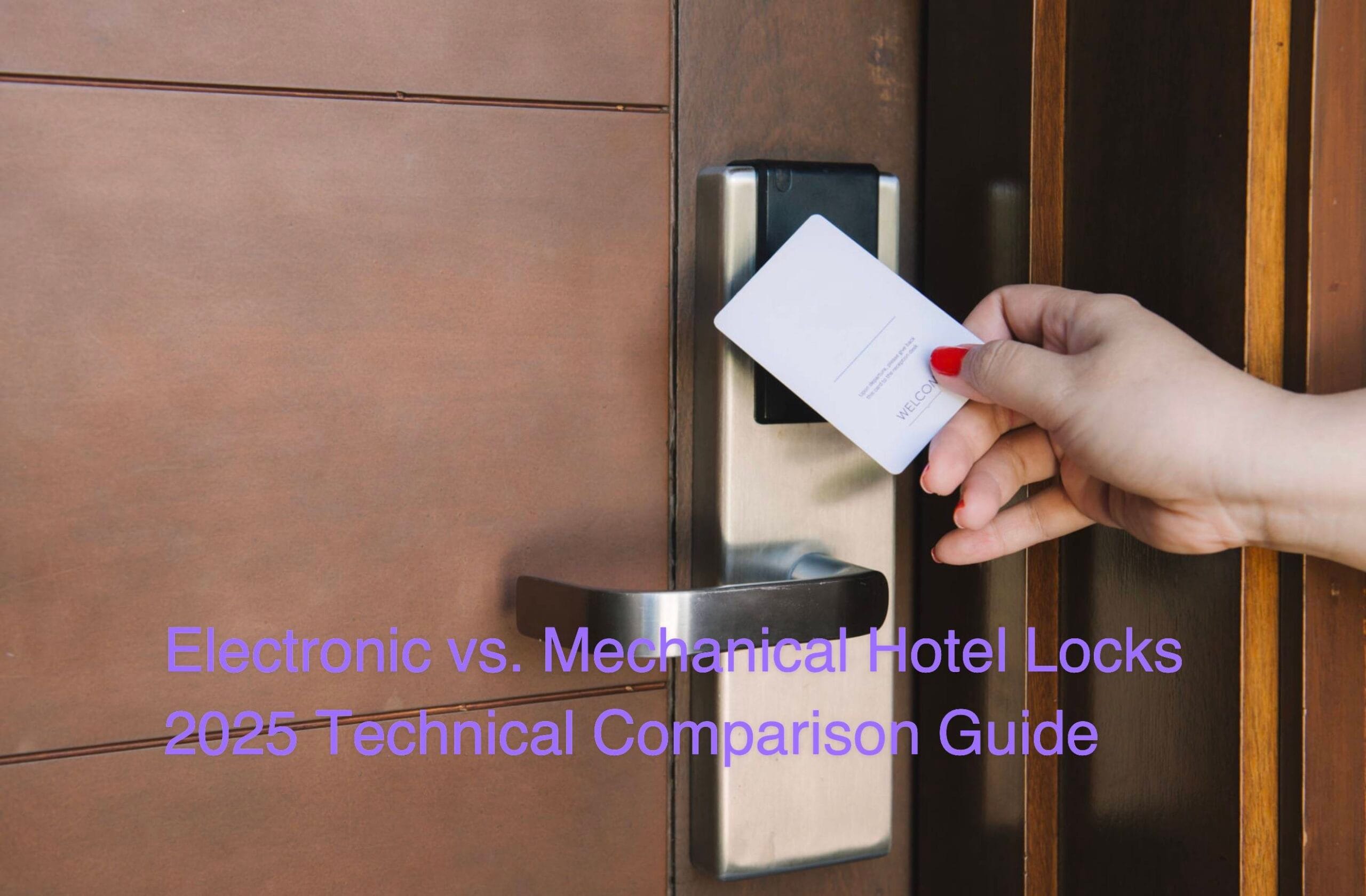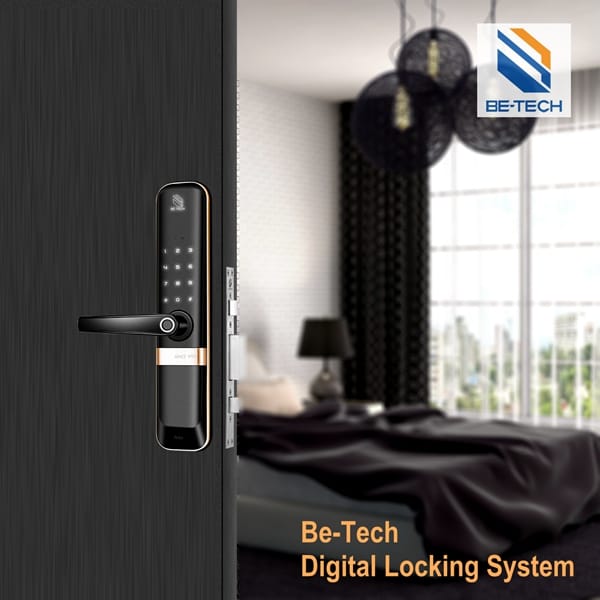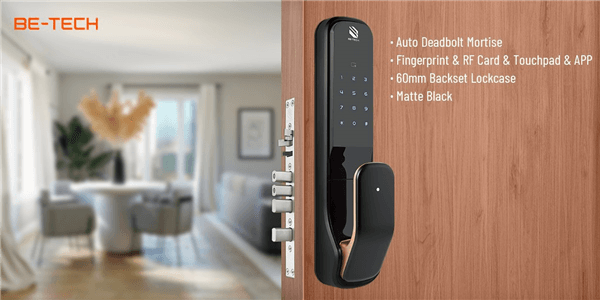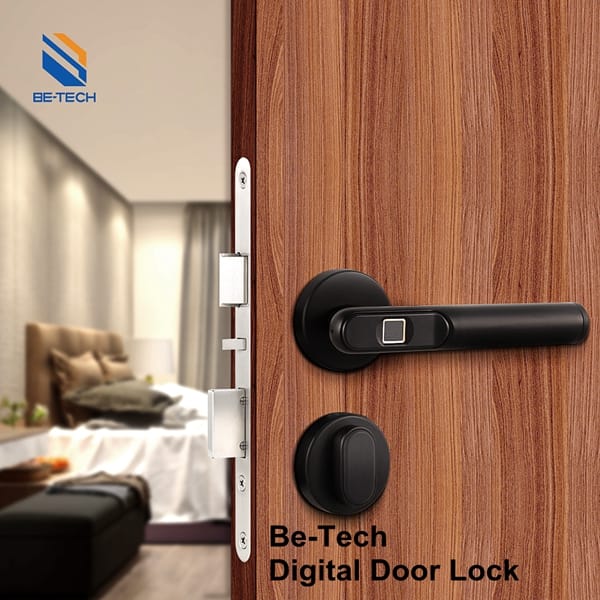In today’s rapidly evolving hospitality landscape, modern hotels are increasingly adopting wireless access control technologies to enhance guest experiences while improving operational efficiency. As we move into 2025, two technologies dominate the hotel access control market: Near Field Communication (NFC) and Bluetooth Low Energy (BLE). This comprehensive comparison examines how these technologies differ in implementation, security frameworks, user experience, and integration capabilities within hotel lock architecture.
Understanding Mobile Access Technology Fundamentals
Before diving into specific comparisons, it’s essential to understand the core technologies that power modern hotel access solutions.
Near Field Communication (NFC) Technology
Near Field Communication (NFC) represents a set of protocols enabling short-range wireless communication between devices. Operating at 13.56 MHz frequency, NFC creates a magnetic induction field that transfers data between compatible devices positioned within approximately 4 centimeters of each other.

NFC in hospitality settings typically operates in three distinct modes:
- Card emulation mode: Allows NFC-enabled smartphones to function like traditional RFID keycards
- Reader/writer mode: Enables phones to read information from NFC tags
- Peer-to-peer mode: Permits two-way communication between devices
The technology emerged commercially when Nokia, Philips, and Sony established the NFC Forum in 2004, creating standards that now govern hotel access implementations. Today’s NFC hotel locks leverage enhanced security protocols including AES-128 encryption and MIFARE DESFire standards to protect access credentials.
Bluetooth Low Energy (BLE) Technology
Bluetooth Low Energy (BLE), also known as Bluetooth Smart, represents a personal area network technology designed specifically for applications requiring minimal power consumption while maintaining communication range. BLE operates in the same 2.4 GHz spectrum as classic Bluetooth but employs a different channel configuration—40 2-MHz channels instead of classic Bluetooth’s 79 1-MHz channels.

In hotel environments, BLE enables:
- Longer-range credential transmission (10-100 meters)
- Continuous background communication with minimal battery impact
- Hands-free access experiences through proximity detection
BLE has seen significant market growth, with projections showing the bluetooth low energy devices market expanding from $25.01 billion in 2025 to $30.08 billion by 2029 at a CAGR of 4.7%. This growth directly impacts hotel technology adoption rates.
NFC vs. BLE: Technical Comparison for Hotel Applications
When evaluating mobile access technologies for hotel implementation, understanding the technical differences becomes crucial for informed decision-making.

Range and Proximity Requirements
The operational range represents one of the most significant differences between these technologies:
| Feature | NFC | BLE | Impact on Hotel Operations |
|---|---|---|---|
| Effective Range | <4 cm (1.5 inches) | 10-100 meters | Determines guest interaction model |
| Activation Method | Tap or hold near lock | Proximity detection | Affects guest convenience |
| Power Requirement | Minimal (can work with powered-off devices) | Active power needed | Influences reliability |
| Connection Speed | Instant connection | Requires pairing/authentication | Impacts check-in efficiency |
NFC’s limited range offers inherent security benefits by requiring deliberate user action—guests must physically present their device to the lock. Conversely, BLE’s extended range enables hands-free access experiences where guests can unlock doors while their phone remains in their pocket or bag.
Power Consumption Considerations
Power efficiency significantly impacts both lock battery life and guest phone usage:
- NFC: Draws negligible power from the mobile device and can function even when the guest’s phone battery is depleted through Apple’s Power Reserve feature
- BLE: Requires continuous power for background communication but optimizes consumption through energy-efficient protocols
According to hospitality implementation data, BLE-enabled locks typically require battery replacement every 12-18 months with normal usage, compared to 18-24 months for NFC-only locks.
Security Protocols and Vulnerability Assessments
Both technologies implement encryption standards, though their security architectures differ substantially:
- NFC Security: Employs short-range limitations as a physical security layer combined with AES-128 encryption; communication occurs only during tap-to-unlock moments
- BLE Security: Requires additional encryption layers and connection protocols to compensate for its extended range; implements rotating security tokens to prevent replay attacks
The Be-Tech Guardian RFID lock system exemplifies modern NFC security implementation with multi-layered encryption and tamper detection features.
Implementation Scenarios in Hotel Environments
Hotel property types and guest demographics significantly influence the optimal mobile access technology choice.
Property Size and Layout Considerations
The physical characteristics of a hotel property can determine which technology proves most effective:
- Large resort properties with expansive grounds often benefit from BLE’s extended range, allowing guests to unlock gates, elevators, and amenity areas from a distance
- Urban boutique hotels with compact layouts frequently prefer NFC’s precise control and reduced infrastructure requirements
- Mixed-use developments increasingly implement hybrid solutions supporting both technologies
According to a 2023 hospitality security report cited by Be-Tech, 78% of hotels with over 200 rooms now opt for centralized access control systems that can manage complex access scenarios across diverse areas.
Guest Demographics and Experience Expectations
Understanding target audience preferences is paramount when selecting mobile access solutions:
- Business travelers typically prioritize:
- Mobile check-in capabilities
- Seamless, efficient entry without fumbling for cards
- Integration with loyalty programs and digital wallets
- Leisure travelers often value:
- Family-friendly access options
- Intuitive interfaces requiring minimal technical knowledge
- Enhanced security features for peace of mind
Recent survey data indicates 65% of business travelers now prefer hotels offering mobile key technology, underscoring the importance of aligning systems with guest expectations.
Integration with Existing Hotel Infrastructure
Compatibility with property management systems (PMS) and existing door hardware represents a critical implementation consideration:
- Retrofit vs. New Installations: NFC-enabled locks often require hardware upgrades for digital wallet integration, while BLE solutions like the Be-Tech Visual II RFID system can be added via modular Bluetooth boards to existing RFID locks
- Backend Management: BLE typically integrates with cloud-based PMS systems for remote key issuance, while NFC relies on secure credential delivery services
- Multi-system Integration: Modern implementations increasingly connect with energy management, room controls, and guest service platforms
Guest Experience and Operational Efficiency
The ultimate goal of mobile access solutions is enhancing the guest journey while streamlining hotel operations.
Check-in Process and Key Distribution
Mobile access technologies fundamentally transform traditional check-in workflows:
- NFC-Based Systems:
- Support digital wallet integration (Apple Wallet, Google Pay)
- Enable instant credential transfer at check-in kiosks
- Work with existing RFID infrastructure
- BLE-Based Systems:
- Allow pre-arrival key delivery to guest devices
- Support location-based automatic check-in
- Enable contactless arrival experiences
The Be-Tech MJM Access Control System demonstrates how advanced mobile access management can integrate with property operations to reduce front-desk congestion and enhance guest satisfaction.
Battery Dependency and Reliability Factors
Operational reliability differs significantly between technologies:
- NFC Access: Functions even with depleted smartphone batteries through Apple’s Power Reserve technology on newer iPhones
- BLE Access: Requires sufficient device power for communication and may be affected by battery-saving modes
This distinction becomes particularly important in emergency scenarios or when guests travel with limited charging opportunities.
Data Analytics and Guest Insights
Modern mobile access systems provide valuable operational intelligence:
- Usage Patterns: Track when and how frequently guests access different areas
- Preference Mapping: Identify amenity utilization through access point data
- Operational Optimization: Adjust staffing based on peak entry/exit times
Hotels implementing advanced mobile access solutions report gaining actionable insights that improve resource allocation and guest satisfaction metrics.
Cost and Implementation Challenges
Financial considerations play a significant role in technology selection.
Hardware Investment Analysis
Implementation costs vary substantially between technologies and installation scenarios:
| Component | NFC Implementation | BLE Implementation |
|---|---|---|
| Lock Hardware | $250-350 per door | $280-450 per door |
| Infrastructure | Minimal additional hardware | BLE beacons/gateways: $80-150 per zone |
| Mobile App Development | $15,000-30,000 customized | $20,000-40,000 customized |
| Maintenance (Annual) | 3-5% of hardware cost | 5-8% of hardware cost |
Hybrid solutions like the Be-Tech Confidant RFID support both technologies but typically command a 15-20% premium over single-technology implementations.
Operational Workflow Adjustments
Transitioning to mobile access requires operational changes:
- Staff Training: Team members need education on troubleshooting and exception handling
- Guest Communication: Clear instructions must be provided for technology adoption
- Backup Systems: Alternative access methods must be maintained for guests without compatible devices
Hotels successfully implementing mobile access typically allocate 20-30 hours of staff training during transition periods.
Security and Privacy Considerations
Security remains paramount in hotel access control systems.
Data Protection Frameworks
Mobile access solutions must adhere to stringent data protection standards:
- Credential Storage: Secure element storage on mobile devices protects against extraction
- Transmission Security: Encrypted communication channels prevent interception
- Audit Trails: Comprehensive logging creates accountability
In 2025, enhanced privacy regulations like GDPR and CCPA continue to influence implementation requirements, with hotels increasingly selecting technologies that minimize personal data exposure while maintaining functionality.
Anti-Cloning and Anti-Tampering Measures
Modern hotel locks implement sophisticated anti-fraud protections:
- NFC Security: Leverages secure element technology and challenge-response authentication
- BLE Security: Employs rotating tokens and device fingerprinting to prevent replay attacks
The Be-Tech Guide to Hotel Lock Standards provides detailed information on security compliance requirements that mobile access solutions must meet.
Future Trends in Hotel Access Technology for 2025 and Beyond
The hotel access landscape continues evolving rapidly with several emerging trends:
Biometric Integration
Next-generation systems increasingly incorporate biometric verification:
- Facial recognition paired with mobile credentials
- Fingerprint authentication as a secondary verification layer
- Voice recognition for hands-free operation
According to technology forecasts, over 35% of luxury hotels will implement biometric-enhanced mobile access by late 2025.
Ecosystem Integration
Access solutions are becoming part of broader hospitality ecosystems:
- Room Personalization: Access credentials trigger personalized room settings
- Service Authentication: Mobile keys authorize charges and service requests
- Loyalty Program Integration: Access technologies enhance reward program experiences
The Be-Tech ECU100 Energy Control Unit demonstrates how access systems connect with in-room energy management to create cohesive guest experiences.
Hybridization of Technologies
The future clearly points toward hybrid implementations that leverage the strengths of both technologies:
- Multi-technology Readers: Support both NFC and BLE communication
- Context-Aware Systems: Select optimal technology based on situation
- Unified Management Platforms: Administer diverse credentials through central systems
Industry leaders like Be-Tech now offer comprehensive solutions supporting multiple access technologies through unified management interfaces.
Selecting the Optimal Solution for Your Property
Determining the best mobile access strategy requires careful assessment of property-specific factors.
Assessment Framework
Consider these key factors when evaluating mobile access options:
- Guest Demographics: Analyze your typical guest profile and technology preferences
- Property Layout: Evaluate physical characteristics that may favor one technology
- Existing Infrastructure: Determine compatibility with current systems
- Security Requirements: Assess risk profile and security compliance needs
- Budget Constraints: Calculate total cost of ownership over a 5-year horizon
The Be-Tech Choosing the Best Hotel Door Lock System guide provides a detailed framework for evaluating these considerations.
Implementation Roadmap
Successful technology adoption follows a structured implementation approach:
- Needs Assessment: Document specific requirements and objectives
- Pilot Program: Test technology in limited deployment
- Staff Training: Develop comprehensive training programs
- Guest Communication: Create clear guest education materials
- Phased Rollout: Implement gradually across property areas
- Continuous Evaluation: Monitor performance and satisfaction metrics
Conclusion: Balancing Technology Choice with Guest Experience
The selection between NFC and BLE for hotel lock architecture ultimately depends on aligning technology capabilities with property needs and guest expectations. While NFC offers enhanced security through its deliberate tap-to-unlock interaction model, BLE provides convenience through hands-free operation and extended range capabilities.
As we move further into 2025, the most successful implementations will likely embrace hybrid solutions that combine both technologies’ strengths while integrating with broader hotel management systems. By carefully evaluating property requirements, guest demographics, and operational objectives, hotels can select mobile access solutions that enhance security, improve operational efficiency, and deliver exceptional guest experiences.
For properties prioritizing seamless guest experiences with robust security frameworks, solutions like the Be-Tech Hotel Door Lock Systems offer comprehensive options supporting multiple access technologies through unified management interfaces.

